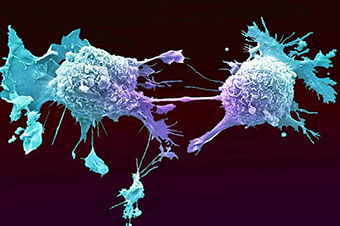Associate Professor Frankie Rawson has recently had an article published in the NewScientist, entitled 'We could kill cancer cells by hijacking their odd electrical current'.

Lung cancer cells dividing
Anne Weston, EM STP, the Francis Crick Institute/SCIENCE PHOTO LIBRARY
Summary:
Frankie has discovered that if you inhibit the external electron transfer of cancerous cells, the cells have limited ways to sustain energy so they'll either be unable to proliferate or they will die.
Paulo Sanjuan-Alberte, also at the University of Nottingham, and Rawson have been developing self-assemnling nano-electrodes which could interact with cancerous cells and alter their electrical signalling.
More detail:
Frankie Rawson and his colleagues have detected subtle changes in the bioelectric currents emanating from different types of cancer cells. These changes hint at what metabolic changes have happened in the cells to enable the rapid division that is characteristic of cancer.
All biological cells use electrons to power themselves. In the early 2000s, however, it was discovered that cells can also send electrons outside their membranes along biological “relays” made of proteins and other molecules. But we didn’t know the significance of this trans-plasma membrane electron transfer (tPMET). “I think we’re only just starting to realise the importance,” says Rawson.
People have long suspected that there is a link between the way cancer cells change their metabolism to spread and grow and changes to the way the cells do this trans-plasma electron transfer.
Normal cells produce almost all of their energy in the mitochondria, their internal “power stations”. But mitochondria can’t power the aggressive demands of a rapidly dividing cancer cell, so cancer cells dial down their mitochondria, and ramp up a metabolic pathway known as glycolysis, which converts sugar into energy.
Rawson and his colleagues looked at the strength of the electrical current for three different lung cancer cell lines, and it showed clear differences, allowing them tell which cancer cells were metastatic, or capable of spreading, and which were still non-invasive.
As the team suspected, when they engineered the cells to reduce the number of tPMET relays, their mitochondria were no longer able to produce enough energy and became overtaxed. But a surprise was in store: instead of the expected slowdown in electron transmission, they saw a “marked increase” in current, Rawson says, as the cells used any remaining tPMETs to fling out as many electrons as possible.
“This was a major, major finding for us,” says Rawson. “Because if you can inhibit that external electron transfer, the cells have limited ways to sustain energy, so they’ll either be unable to proliferate, or they’ll die.”
It also raises another possibility: if we could inhibit the electron transfer, we could starve cancer cells. No drugs are available that can interfere with tPMET, but the new research suggests that we could do it another way.
Paola Sanjuan-Alberte and Rawson have been working on self-assembling nano-electrodes that could interface with cancerous cells to tweak their electrical signalling. These devices apply an electrical field to prevent a cell’s relays from shedding the electrons.
However, Herst and Jeuken both caution that more studies need to be done to gain a deeper understanding of the role this electron transfer plays in normal and in healthy cells.
Thanks to Ali Chapman for her summary of this publication.
Posted on Thursday 4th July 2019